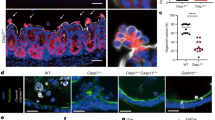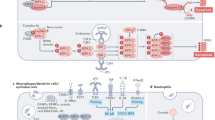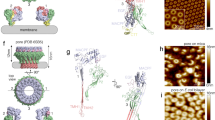Abstract
How the pore-forming protein perforin delivers apoptosis-inducing granzymes to the cytosol of target cells is uncertain. Perforin induces a transient Ca2+ flux in the target cell, which triggers a process to repair the damaged cell membrane. As a consequence, both perforin and granzymes are endocytosed into enlarged endosomes called 'gigantosomes'. Here we show that perforin formed pores in the gigantosome membrane, allowing endosomal cargo, including granzymes, to be gradually released. After about 15 min, gigantosomes ruptured, releasing their remaining content. Thus, perforin delivers granzymes by a two-step process that involves first transient pores in the cell membrane that trigger the endocytosis of granzyme and perforin and then pore formation in endosomes to trigger cytosolic release.
This is a preview of subscription content, access via your institution
Access options
Subscribe to this journal
Receive 12 print issues and online access
$209.00 per year
only $17.42 per issue
Buy this article
- Purchase on Springer Link
- Instant access to full article PDF
Prices may be subject to local taxes which are calculated during checkout






Similar content being viewed by others
References
de Saint Basile, G., Menasche, G. & Fischer, A. Molecular mechanisms of biogenesis and exocytosis of cytotoxic granules. Nat. Rev. Immunol. 10, 568–579 (2010).
Grakoui, A. et al. The immunological synapse: a molecular machine controlling T cell activation. Science 285, 221–227 (1999).
Stinchcombe, J.C., Bossi, G., Booth, S. & Griffiths, G.M. The immunological synapse of CTL contains a secretory domain and membrane bridges. Immunity 15, 751–761 (2001).
Lieberman, J. The ABCs of granule-mediated cytotoxicity: new weapons in the arsenal. Nat. Rev. Immunol. 3, 361–370 (2003).
Dustin, M.L. & Long, E.O. Cytotoxic immunological synapses. Immunol. Rev. 235, 24–34 (2010).
Anthony, D.A., Andrews, D.M., Watt, S.V., Trapani, J.A. & Smyth, M.J. Functional dissection of the granzyme family: cell death and inflammation. Immunol. Rev. 235, 73–92 (2010).
Bovenschen, N. & Kummer, J.A. Orphan granzymes find a home. Immunol. Rev. 235, 117–127 (2010).
Lieberman, J. Granzyme A activates another way to die. Immunol. Rev. 235, 93–104 (2010).
Pasternack, M.S. & Eisen, H.N. A novel serine esterase expressed by cytotoxic T lymphocytes. Nature 314, 743–745 (1985).
Podack, E.R., Young, J.D. & Cohn, Z.A. Isolation and biochemical and functional characterization of perforin 1 from cytolytic T-cell granules. Proc. Natl. Acad. Sci. USA 82, 8629–8633 (1985).
Gershenfeld, H.K. & Weissman, I.L. Cloning of a cDNA for a T cell-specific serine protease from a cytotoxic T lymphocyte. Science 232, 854–858 (1986).
Bleackley, R.C. et al. The isolation and characterization of a family of serine protease genes expressed in activated cytotoxic T lymphocytes. Immunol. Rev. 103, 5–19 (1988).
van den Broek, M.E. et al. Decreased tumor surveillance in perforin-deficient mice. J. Exp. Med. 184, 1781–1790 (1996).
Stepp, S.E. et al. Perforin gene defects in familial hemophagocytic lymphohistiocytosis. Science 286, 1957–1959 (1999).
Katano, H. & Cohen, J.I. Perforin and lymphohistiocytic proliferative disorders. Br. J. Haematol. 128, 739–750 (2005).
Pipkin, M.E. & Lieberman, J. Delivering the kiss of death: progress on understanding how perforin works. Curr. Opin. Immunol. 19, 301–308 (2007).
Voskoboinik, I., Smyth, M.J. & Trapani, J.A. Perforin-mediated target-cell death and immune homeostasis. Nat. Rev. Immunol. 6, 940–952 (2006).
Baran, K. et al. The molecular basis for perforin oligomerization and transmembrane pore assembly. Immunity 30, 684–695 (2009).
Podack, E.R. & Dennert, G. Assembly of two types of tubules with putative cytolytic function by cloned natural killer cells. Nature 302, 442–445 (1983).
Podack, E.R., Konigsberg, P.J., Acha-Orbea, H., Pircher, H. & Hengartner, H. Cytolytic T-cell granules: biochemical properties and functional specificity. Adv. Exp. Med. Biol. 184, 99–119 (1985).
Trapani, J.A. et al. Genomic organization of the mouse pore-forming protein (perforin) gene and localization to chromosome 10. Similarities to and differences from C9. J. Exp. Med. 171, 545–557 (1990).
Tschopp, J., Masson, D. & Stanley, K.K. Structural/functional similarity between proteins involved in complement- and cytotoxic T-lymphocyte-mediated cytolysis. Nature 322, 831–834 (1986).
Keefe, D. et al. Perforin triggers a plasma membrane-repair response that facilitates CTL induction of apoptosis. Immunity 23, 249–262 (2005).
Thiery, J. et al. Perforin activates clathrin- and dynamin-dependent endocytosis, which is required for plasma membrane repair and delivery of granzyme B for granzyme-mediated apoptosis. Blood 115, 1582–1593 (2010).
Froelich, C.J. et al. New paradigm for lymphocyte granule-mediated cytotoxicity. Target cells bind and internalize granzyme B, but an endosomolytic agent is necessary for cytosolic delivery and subsequent apoptosis. J. Biol. Chem. 271, 29073–29079 (1996).
Browne, K.A. et al. Cytosolic delivery of granzyme B by bacterial toxins: evidence that endosomal disruption, in addition to transmembrane pore formation, is an important function of perforin. Mol. Cell. Biol. 19, 8604–8615 (1999).
Reddy, A., Caler, E.V. & Andrews, N.W. Plasma membrane repair is mediated by Ca2+-regulated exocytosis of lysosomes. Cell 106, 157–169 (2001).
McNeil, P.L. & Steinhardt, R.A. Plasma membrane disruption: repair, prevention, adaptation. Annu. Rev. Cell Dev. Biol. 19, 697–731 (2003).
McNeil, P.L. & Kirchhausen, T. An emergency response team for membrane repair. Nat. Rev. Mol. Cell Biol. 6, 499–505 (2005).
Idone, V. et al. Repair of injured plasma membrane by rapid Ca2+-dependent endocytosis. J. Cell Biol. 180, 905–914 (2008).
Bucci, C. et al. The small GTPase rab5 functions as a regulatory factor in the early endocytic pathway. Cell 70, 715–728 (1992).
Olkkonen, V.M. & Stenmark, H. Role of Rab GTPases in membrane traffic. Int. Rev. Cytol. 176, 1–85 (1997).
Armstrong, J. How do Rab proteins function in membrane traffic? Int. J. Biochem. Cell Biol. 32, 303–307 (2000).
Li, G., Barbieri, M.A., Colombo, M.I. & Stahl, P.D. Structural features of the GTP-binding defective Rab5 mutants required for their inhibitory activity on endocytosis. J. Biol. Chem. 269, 14631–14635 (1994).
Forgac, M. Vacuolar ATPases: rotary proton pumps in physiology and pathophysiology. Nat. Rev. Mol. Cell Biol. 8, 917–929 (2007).
Tschopp, J. & Masson, D. Inhibition of the lytic activity of perforin (cytolysin) and of late complement components by proteoglycans. Mol. Immunol. 24, 907–913 (1987).
Yoshimori, T., Yamamoto, A., Moriyama, Y., Futai, M. & Tashiro, Y. Bafilomycin A1, a specific inhibitor of vacuolar-type H+-ATPase, inhibits acidification and protein degradation in lysosomes of cultured cells. J. Biol. Chem. 266, 17707–17712 (1991).
Recchi, C. & Chavrier, P. V-ATPase: a potential pH sensor. Nat. Cell Biol. 8, 107–109 (2006).
Galloway, C.J., Dean, G.E., Marsh, M., Rudnick, G. & Mellman, I. Acidification of macrophage and fibroblast endocytic vesicles in vitro. Proc. Natl. Acad. Sci. USA 80, 3334–3338 (1983).
Praper, T. et al. Human perforin permeabilizing activity, but not binding to lipid membranes, is affected by pH. Mol. Immunol. 47, 2492–2504 (2010).
Jans, D.A., Jans, P., Briggs, L.J., Sutton, V. & Trapani, J.A. Nuclear transport of granzyme B (fragmentin-2). Dependence of perforin in vivo and cytosolic factors in vitro. J. Biol. Chem. 271, 30781–30789 (1996).
D'Arrigo, A., Bucci, C., Toh, B.H. & Stenmark, H. Microtubules are involved in bafilomycin A1-induced tubulation and Rab5-dependent vacuolation of early endosomes. Eur. J. Cell Biol. 72, 95–103 (1997).
Husmann, M. et al. Elimination of a bacterial pore-forming toxin by sequential endocytosis and exocytosis. FEBS Lett. 583, 337–344 (2009).
Pilzer, D., Gasser, O., Moskovich, O., Schifferli, J.A. & Fishelson, Z. Emission of membrane vesicles: roles in complement resistance, immunity and cancer. Springer Semin. Immunopathol. 27, 375–387 (2005).
Praper, T. et al. Human perforin employs different avenues to damage membranes. J. Biol. Chem. 286, 2946–2955 (2010).
Thiery, J., Walch, M., Jensen, D.K., Martinvalet, D. & Lieberman, J. in Current Protocols in Cell Biology Vol. 47 (eds. Bonifacino, J.S., Dasso, M., Harford, J.B., Lippincott-Schwartz, J. & Yamada, K.M.) Unit 3.37, 1–29 (John Wiley & Sons, Hoboken, New Jersey, 2010).
Aricescu, A.R., Lu, W. & Jones, E.Y. A time- and cost-efficient system for high-level protein production in mammalian cells. Acta Crystallogr. D Biol. Crystallogr. 62, 1243–1250 (2006).
Martinvalet, D., Thiery, J. & Chowdhury, D. Granzymes and cell death. Methods Enzymol. 442, 213–230 (2008).
Barbieri, M.A., Li, G., Mayorga, L.S. & Stahl, P.D. Characterization of Rab5:Q79L-stimulated endosome fusion. Arch. Biochem. Biophys. 326, 64–72 (1996).
Acknowledgements
We thank Y. Jones (University of Oxford) for the mammalian expression vector pHLseq; G.M. Griffiths (Oxford University) for 2d4 mouse antibody to human perforin; and E. Marino for assistance with microscopy and image analysis. Supported by the US National Institutes of Health (AI063430 to J.L. and GM075252 to T.K.), the Canadian Institutes of Health Research (R.C.B.), the Canadian Cancer Society (RCB), the Stiefel-Zangger Foundation (M.W.), the Human Frontier Science Program Organization (E.B.), the Harvard Digestive Diseases Center (S.B.) and the Immune Disease Institute and GlaxoSmithKline Alliance (S.B.).
Author information
Authors and Affiliations
Contributions
J.T. designed and did experiments, analyzed data and wrote the manuscript; S.B., D.K. and E.B. did and helped analyze some experiments; M.W. and D.M. purified granzyme B and helped with perforin purification; I.S.G. and R.C.B. developed the NK cell line expressing eGFP–granzyme B; and T.K. and J.L. conceived of and supervised the project, helped design experiments and coordinated the writing of the manuscript.
Corresponding author
Ethics declarations
Competing interests
The authors declare no competing financial interests.
Supplementary information
Supplementary Text and Figures
Supplementary Figures 1–7 and Supplementary Methods (PDF 941 kb)
Supplementary Video 1
PFN-mediated release of endocytosed dextran from a gigantosome. Representative EGFP-EEA-1+ (green) gigantosomes from transfected HeLa cells treated with TR-Dextran (red) and sublytic rat PFN. Live images were acquired by spinning disk confocal microscopy starting 10 min after addition of TR-Dextran and PFN (duration 5 min, 2.5 sec/frame). Selected static individual frames from these movies are shown in Figure 5c. (MOV 2009 kb)
Supplementary Video 2
PFN-mediated release of endocytosed dextran from a gigantosome. Representative EGFP-EEA-1+ (green) gigantosomes from transfected HeLa cells treated with TR-Dextran (red) and sublytic rat PFN. Live images were acquired by spinning disk confocal microscopy starting 10 min after addition of TR-Dextran and PFN (duration 6 min, 10 sec/frame). Selected static individual frames from these movies are shown in Supplementary Figure 6a. (MOV 113 kb)
Supplementary Video 3
PFN-mediated release of endocytosed dextran from a gigantosome. Representative EGFP-EEA-1+ (green) gigantosomes from transfected HeLa cells treated with TR-Dextran (red) and sublytic rat PFN. Live images were acquired by spinning disk confocal microscopy starting 10 min after addition of TR-Dextran and PFN (duration 13.5 min, 10 sec/frame). Selected static individual frames from these movies are shown in Supplementary Figure 6b. (MOV 461 kb)
Rights and permissions
About this article
Cite this article
Thiery, J., Keefe, D., Boulant, S. et al. Perforin pores in the endosomal membrane trigger the release of endocytosed granzyme B into the cytosol of target cells. Nat Immunol 12, 770–777 (2011). https://doi.org/10.1038/ni.2050
Received:
Accepted:
Published:
Issue Date:
DOI: https://doi.org/10.1038/ni.2050
This article is cited by
-
Natural killer cell-derived exosomes for cancer immunotherapy: innovative therapeutics art
Cancer Cell International (2023)
-
Exploiting autophagy balance in T and NK cells as a new strategy to implement adoptive cell therapies
Molecular Cancer (2023)
-
The Pyroptotic and Nonpyroptotic Roles of Gasdermins in Modulating Cancer Progression and Their Perspectives on Cancer Therapeutics
Archivum Immunologiae et Therapiae Experimentalis (2023)
-
Endosomal Escape of Bioactives Deployed via Nanocarriers: Insights Into the Design of Polymeric Micelles
Pharmaceutical Research (2022)
-
Bispecific T cell engagers: an emerging therapy for management of hematologic malignancies
Journal of Hematology & Oncology (2021)



